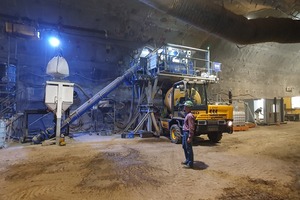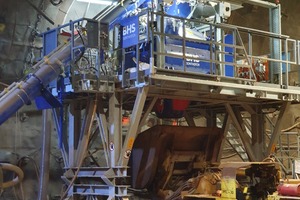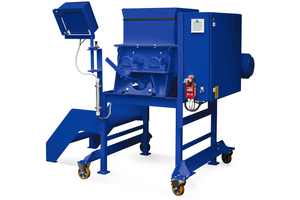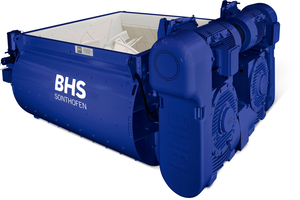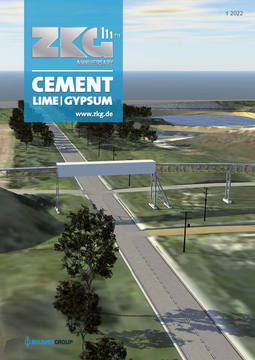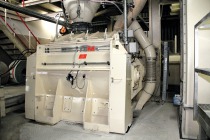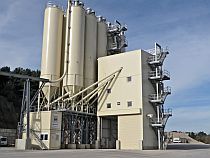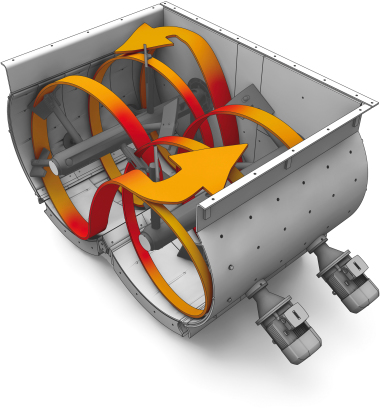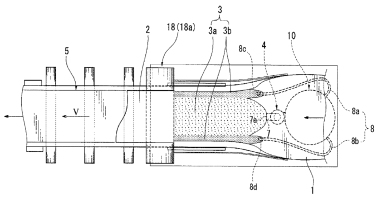Twin-shaft batch mixer deployed underground
What is to be done when there is no empirical data for the production conditions of using a mixer in advance? And what to do furthermore if the construction site of the mixer is difficult to access? These were the initial conditions that BHS-Sonthofen had to contend with as part of the ARGE ETS Konrad mine project in Salzgitter-Bleckenstedt/Germany. It had to design a BHS twin-shaft batch mixer and deliver a custom-designed mixing plant.
The mixing plant will produce wet shotcrete (0-4 mm) from dry compound with different concrete additives and achieve an optimum end product – in a mine located 1000 m underground.
“We use the BHS laboratory mixer of type DKX 0.06 S to meet any requirement for which we still do not have any example cases available in our portfolio of previous projects,” explains Eckhard Rößner, who is responsible for the building materials machinery sales force in the region. Those responsible at the ARGE ETS mine used this scaled-down version of the large BHS twin-shaft batch mixer to test what the optimal design for the ready-mixed shotcrete (grain and cement) would be and how it needed to be processed for use in the mine. To be more specific, the mixing plant should produce 20 to 25 m3 of wet shotcrete per concrete pour with a concreting time of four to six hours. The consistency range for the finished product is F2/F3. The key here is maintaining the exact water-cement ratio of 0.45 set out in the requirements specified for exposure class XA3.
A successful test led to a successful order
To get the best idea of how the BHS twin-shaft batch mixer works and the results it delivers, the cooperation between ARGE and BHS started with the rental of the laboratory mixing station. The team performed a two-stage test starting in August 2020. The first stage took place on the premises of ARGE stakeholder Schachtbau Nordhausen, with the second stage then taking place underground. They tested all of the functions and performance features of the mixing system, as well as the combination of dry mixes with additives from various suppliers. “It was important for us to experiment and develop the ideal product characteristics before investing in a large plant. The laboratory system from BHS provided the perfect conditions for us to do this in,” emphasizes Marcel Hahn, a project manager at ARGE. To produce wet shotcrete underground, a dry compound from big bags with a maximum grain size of 4 mm is used to which steel fibers are added during the mixing process. Once the concrete is mixed, the end product is loaded into a special truck mixer that has a capacity of 3.5 m3 and is transported to the concrete pump.
Complicated logistics for onsite installation
ARGE ordered the custom-designed BHS “Stabimix 0.75” mixing plant at the beginning of October 2020 following the successful test with the machine in the lab. In addition to the BHS twin-shaft batch mixer of type DKX 0.75, the delivery scope also included all of the peripheral equipment and a process and dosing control system developed inhouse by the BHS control systems department. Equipment designed to make the already difficult working conditions underground easier to deal with, such as a high-pressure cleaning system for the mixer and a central lubrication system, rounded off the delivery scope. “After we had placed the order, we still had a few logistical demands to deal with in terms of having the installation components delivered,” explains Rößner. “We couldn’t simply deliver and install the plant and equipment in the same way we normally would at other sites. Instead, we had to deliver them divided into logical individual components and transport them to a depth of 1000 m using a shaft hoisting system.”
The clear specifications for the dimensions of the components and transport containers included a maximum component format of 2300 mm deep x 2700 mm wide and a maximum weight of 5000 kg. In total, BHS transported around 45 individual pieces down to the mine in line with these project specifications. Delivering and transporting the components underground were not the only things that required meticulous planning – everything from the location of the hoist to where the mixer will actually be used (an area of approx. 3 km) on a base measuring 1000 m did, too. The final installation process also had to be designed using completely different work steps to the usual procedure, since deliveries are normally comprised of much larger assemblies than the one at this underground construction site. Tools and work materials were planned with safety reserves, as the complex logistics of the situation meant additional deliveries would not arrive quickly enough.
Laboratory machine guarantees reproducible mixtures
Installation onsite started at the beginning of February 2021. To this end, BHS installation specialists prepared themselves for working underground. A lead installation technician, an electrician and a control specialist underwent a physical specifically for this task and received training in working underground and the occupational safety regulations that apply in that environment. The batch mixer and its peripherals were installed and commissioned in around four weeks with the support of ARGE personnel. “Production with the BHS plant went live in the early part of summer 2021 and we can implement the exact conditions we tested in the lab here underground. It worked really well. That’s why we decided to buy the machine from the lab as well,” says Hahn. “This also allows us to perform detailed dosing and mixing tests for other projects before we start them since the lab results are representative of the production machines.” This means that ARGE ETS has the safest operation possible when it comes to concreting work in underground projects as a result.

